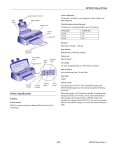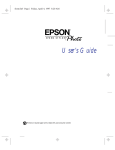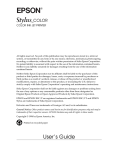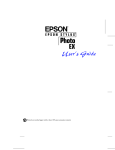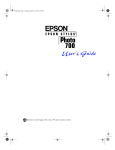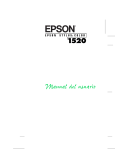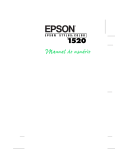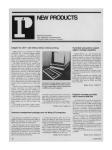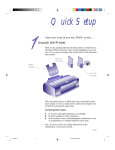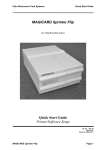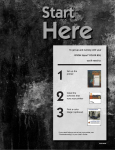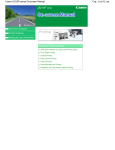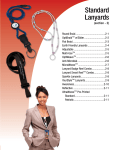Download Epson Stylus Color II Ink Jet Printer User Setup Information
Transcript
COLOR INK JET PRINTER Setup and Software Guide for Windows ® All rights reserved. No part of this publication may be reproduced, stored in a retrieval system, or transmitted in any form or by any means, electronic, mechanical, photocopying, recording, or otherwise, without the prior written permission of Seiko Epson Corporation. No patent liability is assumed with respect to the use of the information contained herein. Neither is any liability assumed for damages resulting from the use of the information contained herein. Neither Seiko Epson Corporation nor its affiliates shall be liable to the purchaser of this product or third parties for damages, losses, costs, or expenses incurred by purchaser or third parties as a result of: accident, misuse, or abuse of this product or unauthorized modifications, repairs, or alterations to this product, or (excluding the U.S.) failure to strictly comply with Seiko Epson Corporation’s operating and maintenance instructions. Seiko Epson Corporation shall not be liable against any damages or problems arising from the use of any options or any consumable products other than those designated as Original EPSON Products or EPSON Approved Products by Seiko Epson Corporation. EPSON and EPSON Stylus are registered trademarks and ESC/P 2 is a trademark of Seiko Epson Corporation. EPSON Connection is a service mark of Epson America, Inc. Windows printer driver copyright Software 2000 Ltd Oxford, England. Portions copyright Seiko Epson Corporation. General Notice: Other product names used herein are for identification purposes only and may be trademarks of their respective owners. EPSON disclaims any and all rights in those marks. The Energy Star emblem does not represent EPA endorsement of any product or service. Copyright © 1995 by Epson America, Inc. Printed on recycled paper with at least 10% post-consumer content 10/95 FCC Compliance Statement For United States Users This equipment has been tested and found to comply with the limits for a Class B digital device, pursuant to Part 15 of the FCC Rules. These limits are designed to provide reasonable protection against harmful interference in a residential installation. This equipment generates, uses, and can radiate radio frequency energy and, if not installed and used in accordance with the instructions, may cause harmful interference to radio or television reception. However, there is no guarantee that interference will not occur in a particular installation. If this equipment does cause interference to radio and television reception, which can be determined by turning the equipment off and on, the user is encouraged to try to correct the interference by one or more of the following measures. ❑ Reorient or relocate the receiving antenna. ❑ Increase the separation between the equipment and receiver. ❑ Connect the equipment into an outlet on a circuit different from that to which the receiver is connected. ❑ Consult the dealer or an experienced radio/TV technician for help. WARNING The connection of a non-shielded equipment interface cable to this equipment will invalidate the FCC Certification of this device and may cause interference levels which exceed the limits established by the FCC for this equipment. It is the responsibility of the user to obtain and use a shielded equipment interface cable with this device. If this equipment has more than one interface connector, do not leave cables connected to unused interfaces. Changes or modifications not expressly approved by the manufacturer could void the user’s authority to operate the equipment. For Canadian Users This digital apparatus does not exceed the Class B limits for radio noise emissions from digital apparatus as set out in the radio interference regulations of the Canadian Department of Communications. Le présent appareil numérique n’émet pas de bruits radioélectriques dépassant les limites applicables aux appareils numériques de Classe B prescrites dans le règlement sur le brouillage radioélectrique édicté par le Ministère des Communications du Canada. ii Contents Introduction Getting the Most Out of Your Printer . Three Resolutions to Choose From Special Papers . . . . . . . . . . . . Specially Formulated Ink . . . . . . Automatic Printer Driver Settings . If You Are New to Color Printing . . . Where to Get Help . . . . . . . . . . . Electronic Support Services . . . . Important Safety Instructions . . . . . . . . . . . . . . . . . . . . . . . . . . . . . . . . . . . . . . . . . . . . . . . . . . . . . . . . . . . . . . . . . . . . . . . . . . . . . . . . . . . . . . . . . . . . . . . . . . . . . . . . . . . . . . . . . 2 2 2 3 3 3 5 6 7 System Requirements . . . . . . . . . . . . . Choosing a Location . . . . . . . . . . . . . Unpacking the Printer . . . . . . . . . . . . Removing the Protective Materials . . . Setting Up the Printer . . . . . . . . . . . . . Attaching the Paper Support . . . . . . . Plugging In and Turning On the Printer Installing the Ink Cartridges . . . . . . . Checking the Paper Thickness Lever . . Loading Paper . . . . . . . . . . . . . . . Testing the Printer . . . . . . . . . . . . Connecting the Printer to Your PC . . . . . . . . . . . . . . . . . . . . . . . . . . . . . . . . . . . . . . . . . . . . . . . . . . . . . . . . . . . . . . . . . . . . . . . . . . . . . . . . . . . . . . . . . . . . . . . . . . . . . . . . . . . . . . . . . . . . . . . . . . . . . . . . . . . . . . . . . 1-1 1-2 1-2 1-3 1-3 1-4 1-4 1-5 1-10 1-10 1-12 1-13 Chapter 1 . . . . . . . . . . . . . . . . . . Installing the Printer iii Chapter 2 Installing and Using the Printer Driver Installing the Windows Printer Software . . . . . . Installing the Printer Software for Windows 3.1 Installing the Printer Software for Windows 95 Installing a Driver for DOS Programs . . . . . . . . Using the Windows Printer Driver . . . . . . . . . . Accessing the Driver . . . . . . . . . . . . . . . . Using the Driver Dialog Box . . . . . . . . . . . Changing Settings . . . . . . . . . . . . . . . . . Document Type . . . . . . . . . . . . . . . . . . . Paper Settings . . . . . . . . . . . . . . . . . . . . Printing Mode/Options Settings . . . . . . . . . Image Settings . . . . . . . . . . . . . . . . . . . . Halftoning Settings . . . . . . . . . . . . . . . . . Chapter 3 . . . . . . . . . . . . . . . . . . . . . . . . . . . . . . . . . . . . . . . . . . . . . . . . . . . . . . . . . . . . . . . . . . . . . . . . . . . . . . . . . . . . . . . . . . . 2-1 2-2 2-4 2-7 2-7 2-8 2-10 2-12 2-13 2-15 2-16 2-19 2-21 Using the Printer Driver Utilities Managing Print Jobs with Spool Manager . . . . . . . . . . . . . 3-1 Calibrating the Printer with Bi-D Calibration . . . . . . . . . . . 3-3 Index iv Introduction The EPSON® Stylus® COLOR II is an affordable, high-quality ink jet printer that can print up to 16 million colors at a resolution of 720 × 720 dpi to produce full-color, photo-quality images. The printer also produces realistic grayscale images, sharp text, and line art. The printer’s ink jet technology allows it to operate quietly, keeping your workspace peaceful. The Stylus COLOR II is easy to install and use. You simply set it up and install the Microsoft® Windows® printer driver software as described in this book. The printer has built-in parallel and serial interfaces, so you can connect it to an IBM® PC compatible computer or an Apple® Macintosh.® You can even connect both simultaneously; the printer automatically switches between interfaces as it receives print data. Note: For instructions on using the printer with a Macintosh, see the Setup and Software Guide for Macintosh. This manual explains how to do the following: ❑ Set up your printer, load plain paper, connect it to your computer, and test it. See Chapter 1 to begin. ❑ Install and use the printer driver to print your documents. See Chapter 2 for step-by-step instructions. ❑ Manage your print jobs and calibrate the printer using the utilities that came with the printer driver; see Chapter 3. After you’ve installed the driver, select the ReadMe icon in the EPSON program group in Windows for the latest information. Refer to the Reference Guide for instructions on operating and maintaining your printer, as well as for troubleshooting steps and technical specifications you may need. Introduction 1 Getting the Most Out of Your Printer The printer supports a wide variety of settings that let you improve print quality or speed up printing. You can customize these settings using the printer driver to produce a variety of image types with EPSON’s specially formulated inks and papers. Three Resolutions to Choose From Resolution is a measure of the amount of detail that can be represented. The higher the resolution, the more detailed and realistic the image, and the longer it takes to print. For printed images, resolution is measured in dots per inch (dpi). The printer has three resolutions, or printing modes: 720 dpi, 360 dpi, and 180 dpi. Use 720 dpi for the best possible images. For high-quality images in less time, use 360 dpi. When speed is important and draft quality is good enough, use 180 dpi. For guidelines on selecting the best resolution for your print job, see Chapter 2. Special Papers The type of paper you use is very important. Although you get good results with plain bond paper, you will get better results by using coated papers because they do not absorb as much ink. To ensure the best possible quality, EPSON offers special coated papers, glossy papers, and transparencies that are formulated specifically for the inks used by the printer. You can order these products directly from EPSON Accessories at (800) 873-7766 (U.S. sales only). In Canada call (800) BUY-EPSON for sales locations. For more information about special papers and other media, see Chapter 1 of the Reference Guide. 2 Introduction Specially Formulated Ink EPSON’s black and color ink cartridges are specially formulated to work with EPSON papers and the driver to deliver the best looking images. Always use genuine EPSON ink cartridges and do not refill them. Other products may cause damage not covered by EPSON’s warranty. Automatic Printer Driver Settings The printer driver includes an automatic Document Type option that sets the Ink, Color Matching, and Halftone printer driver settings for you, as described in Chapter 2. When set, the driver analyzes the elements on a page to be printed and automatically adjusts the settings so your printed results are appropriate for the image type. If You Are New to Color Printing Color printing with the EPSON Stylus COLOR II produces amazing images, whether you print text, line drawings, photographs, or documents containing many different image types. However you use your color printer, keep the following in mind: ❑ You need to leave a large amount of hard disk drive space free to make room for your color images. A full-page color photographic image, for example, may require 40MB or more of disk space, depending on the resolution. To reduce the file size, you can decrease the size and resolution of your images using your printer driver and application software. Introduction 3 ❑ Color printing takes time because of the complex processing required to create a color image. How much time depends on the size and type of your image, the resolution you use, the speed of your computer, and the interface type. (Serial printing takes longer than parallel printing.) However, the fantastic results make the time spent well worth it. ❑ Your screen colors will not exactly match the printed colors because your monitor screen and the printer use different methods to produce the colors you see. If you scan images using a scanner, the image goes through another interpretive process that also affects the color. Monitors and scanners produce colors by combining red, green, and blue—the RGB method. Your monitor can produce up to 16 million colors by turning on and off the tiny red, green, and blue phosphors contained in each pixel on the screen. Colors produced this way differ from colors produced by your printer’s cyan, magenta, yellow, and black ink—the CMYK method. Your printer driver’s Document Type settings help you closely match colors as appropriate for your image type, resolution, and paper. If you need extreme precision in matching colors, you can use a color calibration system available with many software applications. If you use a scanner, make sure your scanning software is set to the correct setting for ink jet printers to help you match colors. Also, your application may include image editing capabilities that let you adjust the colors. 4 Introduction Where to Get Help If you purchased your printer in the United States or Canada and you need technical assistance, you can call an EPSON Color Specialist at (800) 788-0343. EPSON also provides customer support and service through a network of Authorized EPSON Customer Care Centers and provides the following services when you dial (800) 922-8911: ❑ EPSON technical information library fax service ❑ Product literature on current and new products ❑ Assistance in locating your nearest Authorized EPSON Reseller or Customer Care Center ❑ Technical information on the installation, configuration, and operation of EPSON products ❑ Customer relations. You can purchase ink cartridges, paper, parts, printed manuals, and accessories for EPSON products from EPSON Accessories at (800) 873-7766 (U.S. sales only). In Canada, call (800) BUY-EPSON. If you purchased your printer outside the United States or Canada, contact your EPSON dealer or the marketing location nearest you for customer support and service. If you need help with any software program you are using, see that program’s documentation for technical support information. Introduction 5 Electronic Support Services If you have a modem, the fastest way to access helpful tips, specifications, drivers, application notes, DIP switch or jumper settings, and bulletins for EPSON products is through the online services below. World Wide Web If you are connected to the Internet and have a Web browser, you can access EPSON’s World Wide Web site at http://www.epson.com. EPSON’s home page links users to What’s New, EPSON Products, EPSON Connection, Corporate Info and EPSON Contacts. Link to the EPSON Connection for the latest drivers and FAQs (Frequently Asked Questions) and the EPSON Chat area. To get in touch with EPSON around the world, EPSON Contacts includes Contact Information for local EPSON subsidiaries. SM EPSON Bulletin Board Service You can call the EPSON Bulletin Board Service (BBS) at (310) 782-4531. No membership is required. Make sure your communications software is set to 8 data bits with 1 stop bit, no parity bit, and a modem speed of 28.8 Kbps or less. See the documentation that came with your communications software for more information. CompuServe online support CompuServe® members can call the Epson America Forum on CompuServe. If you are already a member, simply type GO EPSON at the menu prompt to reach the Forum. If you are not currently a member, you are eligible for a free introductory membership as an owner of an EPSON product. 6 Introduction This membership entitles you to: ❑ An introductory credit on CompuServe ❑ Your own user ID and password ❑ A complimentary subscription to CompuServe Magazine, CompuServe’s monthly publication. To take advantage of this offer, call (800) 848-8199 in the United States and Canada and ask for representative #529. In other countries, call the following U.S. telephone number: (614) 529-1611, or your local CompuServe access number. Important Safety Instructions Before using your printer, read the following safety instructions to make sure you use it safely and effectively. ❑ Turn off and unplug the printer before cleaning. Clean with a damp cloth only. Do not spill liquid on the printer. ❑ Do not place the printer on an unstable surface or near a radiator or heat register. ❑ Do not block or cover the openings in the printer’s cabinet or insert objects through the slots. ❑ Use only the type of power source indicated on the printer’s label. ❑ Connect all equipment to properly grounded power outlets. Avoid using outlets on the same circuit as photocopiers or air control systems that regularly switch on and off. ❑ Do not let the power cord become damaged or frayed. Introduction 7 ❑ If you use an extension cord with the printer, make sure the total ampere rating of the devices plugged into the extension cord does not exceed the cord’s ampere rating. Also, make sure the total of all devices plugged into the wall outlet does not exceed 15 amperes. ❑ Except as specifically explained in the Reference Guide, do not attempt to service the printer yourself. ❑ Unplug the printer and refer servicing to qualified service personnel under the following conditions: If the power cord or plug is damaged; if liquid has entered the printer; if the printer has been dropped or the cabinet damaged; if the printer does not operate normally or exhibits a distinct change in performance. Adjust only those controls that are covered by the operating instructions. 8 Introduction Chapter 1 Installing the Printer This chapter tells you how to do the following to get your printer up and running: ❑ Make sure your computer system meets the recommended requirements for use with the printer ❑ Choose the best possible location for your system ❑ Unpack your printer ❑ Set up the printer for use ❑ Connect the printer to your computer. System Requirements To use your printer and its driver, we recommend you have: ❑ 80386/25 MHz or faster processor ❑ Microsoft Windows 3.1, Windows for Workgroups 3.1, or Windows 95 ❑ At least 8MB of available RAM (more for Windows 95) ❑ A minimum of 10MB of hard disk space for storing images (40MB or more is recommended) ❑ A shielded, twisted-pair parallel cable (6 to 10 feet long) to connect your computer to the printer’s parallel interface; the cable must have a D-SUB, 25-pin male connector for the computer and a 36-pin, Centronics® compatible connector for the printer. ❑ VGA or higher standard monitor. Installing the Printer 1-1 Choosing a Location When choosing a location for the printer, use a surface that is flat, horizontal, and stable. Avoid locations subject to rapid changes in temperature and humidity. Also keep the printer away from direct sunlight, heat sources, and sources of electromagnetic interference, such as the base units of cordless telephones. Always leave adequate space around the printer to accommodate its cables. Unpacking the Printer In addition to this guide, your printer box should include two EPSON printer driver diskettes, a Reference Guide, packets of sample paper, a Notice Sheet, and these items: paper support printer black ink cartridge 1-2 Installing the Printer color ink cartridge Removing the Protective Materials You must remove all protective materials packed around and inside your printer before you set it up and turn on the power. Save all packaging and protective materials in case you need to transport the printer in the future. It should always be transported in its original packaging or equivalent materials. First remove the transportation screw securing the print head to the carriage. Flip down the output tray and lift up the printer cover. Loosen the transportation screw by turning its handle counterclockwise; then lift it off the carriage. Save the screw so you can reinstall it if you transport your printer later. (See Chapter 3 of the Reference Guide for more information on transporting the printer.) Follow the directions on the Notice Sheet (packed with the printer) to remove the rest of the protective materials. Setting Up the Printer The following installation procedures describe how to set up and test the printer before you connect it to your PC. Refer to the illustrations on the inside front cover of this manual to identify the main components while setting up the printer. Installing the Printer 1-3 Attaching the Paper Support Insert the tabs on the base of the paper support into the slots at the back of the printer. Plugging In and Turning On the Printer Follow these steps to plug in and turn on the printer: 1. Make sure you have removed all protective packing materials from inside the printer. (See page 1-3 for more information.) 1-4 Installing the Printer 2. Make sure the printer is turned off by checking the position of the POWER switch, as shown below. 3. Plug the power cord into a properly grounded electrical outlet. 4. Turn on the printer by pressing the POWER switch. Installing the Ink Cartridges Follow the steps in this section to install your printer’s ink cartridges. w Warning: The ink cartridges are self-contained units. Under ordinary use, ink will not leak from a cartridge. If ink gets on your hands, wash them thoroughly with soap and water. If ink gets into your eyes, flush them immediately with water. c Caution: Do not open the ink cartridge packages until just before you install them or they may become too dry. Installing the Printer 1-5 1. Make sure the printer is turned on. 2. Lower the output tray at the front of the printer. Then lift up the printer cover using the notches at both sides. 2 1 w Warning: Never insert your hand into the paper path behind the center of the cover; you may injure your hand. 3. Hold down the Alt button for about five seconds until the print head moves slightly to the left, the ink cartridge install position. The Pause light begins flashing. c 1-6 Caution: Never move the print head by hand; always use the Alt button to move it. Installing the Printer 4. Pull up each of the ink cartridge clamps to open them. protective sheet 5. Remove the protective sheet from the color cartridge holder. 6. Open the foil ink cartridge packages and take out the cartridges. Remove the tape seal from the top of each one. black cartridge c color cartridge Caution: You must remove the tape seal from the top of the cartridges; leaving the tape on will permanently damage them. Do not remove the tape seal from the bottom of the cartridge; ink will leak out. Installing the Printer 1-7 7. The color cartridge, which is larger, goes on the right. Install the black ink cartridge on the left. Lower the cartridges into their holders with the labels facing up and the arrow on the top pointing toward the back of the printer. Be sure to install both ink cartridges. The printer will not work if only one cartridge is installed. 8. Push down the ink cartridge clamps until they lock in place. 1-8 Installing the Printer c Caution: Once you install the ink cartridges, do not open the clamps or remove the cartridges except to replace them with new ones. Once you remove a cartridge, do not reuse it. Reusing a cartridge that has been removed may damage the print head. 9. Press the Alt button again to return the print head to its home position. (Even if you do not press Alt, the print head moves back to its home position about 30 seconds after you close the clamps.) After you install the ink cartridges, the printer charges the ink delivery system. This takes about two minutes. During this time, the Pause light flashes. When the printer is finished charging, the Pause light stays on without flashing. c Caution: Never turn off the printer when the Pause light flashes. 10. Close the printer cover. In order to maintain optimum print quality, the printer periodically performs a cleaning operation. You may notice the cleaning cycle being performed when the printer has been on for awhile without being used or when you turn it on after it has been off for awhile. You may need to manually activate a cleaning cycle if you notice a decline in print quality; see Chapter 3 of the Reference Guide. c Caution: When you need to replace ink cartridges, be sure to use only genuine EPSON ink cartridges and do not refill them. Other products may cause damage not covered by EPSON’s warranty. Installing the Printer 1-9 Checking the Paper Thickness Lever Before you load paper, make sure that the paper thickness lever, which controls the distance between the paper and the printer carriage, is set correctly. thick paper setting plain paper setting If necessary, move the lever to the plain paper setting. For instructions on setting the lever for special paper or other media, see Chapter 1 of the Reference Guide. Loading Paper The following procedure explains how to load plain bond paper. For instructions on loading coated or glossy paper, envelopes, and transparencies, see Chapter 1 of the Reference Guide. You can load up to 100 sheets of plain paper. For paper specifications, see Appendix A of the Reference Guide. Always load plain paper with the printable surface facing up. The printable surface is marked with an arrow on most plain paper packaging. 1-10 Installing the Printer 1. Slide the left edge guide on the sheet feeder to the left as far as it will go. 2. Fan a stack of paper; then tap it on a flat surface to even the edges. 3. Load the stack of paper, printable side up, so that its right edge is firmly against the right side of the sheet feeder. Then slide the left edge guide against the left edge of the paper. Do not load paper above the arrow printed on the inside of the left edge guide on the sheet feeder. Installing the Printer 1-11 Testing the Printer Before continuing, test the printer to ensure it is functioning properly. For the self test, use paper that is at least 8.25 inches (210 mm) wide. 1. Press the POWER switch to turn off the printer. c Caution: Never turn off the printer by unplugging it or turning off a power strip. Always turn off the printer by pressing the POWER switch. 2. Hold down the Load/Eject button while pressing the POWER switch to turn on the printer. Keep holding down Load/Eject until the printer feeds a page. The 360 dpi self test begins by printing in black ink on the first and last lines of the first sheet of paper to measure the page length. Then it prints character samples on the next sheet using the available fonts and colors. 3. To end the self test, press the Pause button and then turn off the printer. Otherwise, the test continues until the paper in the sheet feeder runs out. (If a partial page feeds before you press Pause, press Load/Eject to clear the paper path.) c Caution: Do not turn off the printer before pressing the Pause button. If the quality of the test output is not good, clean the print heads as described in Chapter 3 of the Reference Guide. (It may take as many as five cleaning cycles to fully solve the problem.) 1-12 Installing the Printer Connecting the Printer to Your PC You need a shielded, twisted-pair parallel cable (6 to 10 feet long) to connect your computer to the printer’s built-in parallel interface. The cable must have a D-SUB, 25-pin male connector for your computer and a 36-pin, Centronics compatible connector for the printer. 1. Make sure both the printer and computer are turned off. 2. Plug the 36-pin end of the cable securely into the printer’s interface connector. Then squeeze the wire clips together until they lock in place on both sides. If your cable has a ground wire, attach it to the ground connector below the interface connector. 3. Plug the 25-pin end of the cable into the computer’s parallel interface; see the instructions in your computer manual. 4. Turn on the printer by pressing the POWER switch and then turn on your computer. Now see Chapter 2 for instructions on installing and using the printer driver. Installing the Printer 1-13 1-14 Installing the Printer Chapter 2 Installing and Using the Printer Driver This chapter describes how to install the Windows printer driver and its utilities and how to use the driver to control printer settings such as media type, document type, printing mode, and halftoning. (To install a driver for DOS programs, see page 2-7.) Installing the Windows Printer Software A printer driver is software that allows your computer to control the printer. You must install a printer driver to use the printer. The Windows printer driver diskette contains the Windows printer driver and utilities for PC users. Also included on the diskette are two utilities: the EPSON Spool Manager and the Bi-D Calibration Utility. When you install the printer driver, the EPSON Spool Manager is automatically copied to your hard disk. You can copy the Bi-D Calibration Utility to your hard disk or run it from the diskette when needed. (See Chapter 3 for instructions on running these utilities.) Note: It is a good idea to make a backup copy of your driver diskette. If you are using Windows 3.1, follow the steps in the next section to install the printer software. If you are running Windows 95, see page 2-4 for instructions. Installing and Using the Printer Driver 2-1 Installing the Printer Software for Windows 3.1 Follow these steps to install the printer software for Windows 3.1: 1. Turn on your printer and computer. 2. Make sure Windows is running. 3. Insert the Windows printer driver diskette in a diskette drive. 4. In the File menu, select Run. You see the Run dialog box. 5. In the Command Line box, type A:SETUP (or B:SETUP if you inserted the diskette in drive B). Press Enter or click OK. You see the EPSON Printer Driver Setup dialog box. 6. Highlight Epson Stylus COLOR II in the Printer Driver pull-down menu and click Continue. The installation program begins copying the driver files. You see a screen showing the progress of the installation as it proceeds. After a few moments, the installation program creates the EPSON program group in Windows containing these three icons: Spool Manager EPSON Stylus Help EPSON Stylus ReadMe When the installation is complete, you see a confirmation screen. 7. Click OK to exit the installation program. The installation program automatically selects the EPSON Stylus COLOR II printer as your default printer for Windows applications. It also assigns the printer driver to port LPT1. If you need to change the default printer driver or the port assignment, see the next section. 2-2 Installing and Using the Printer Driver Note: If you installed the printer driver using Windows 3.1 and will upgrade to Windows 95, be sure to reinstall the driver using the steps beginning on page 2-4 after you install Windows 95. This sets up the driver correctly for Windows 95. Now you can access the driver from your Windows programs to control your printer settings; see page 2-7 for instructions. Changing the default printer or printer port If you do not want to use the EPSON Stylus COLOR II printer driver as your default printer in Windows or if you want to use it on a different printer port, follow these steps: 1. In the Main window, double-click the Control Panel icon. 2. Double-click the Printers icon. The Printers dialog box appears. 3. In the Installed Printers pull-down list, select the printer you want to use as your default printer. 4. Click the Set As Default Printer button. If you do not need to change the printer port assignment for the EPSON Stylus COLOR II printer, go to step 9. 5. To change the port assignment, select EPSON Stylus COLOR II in the Installed Printer pull-down list. 6. Click the Connect button. You see the Connect dialog box. 7. In the Ports pull-down list, select the port to which you want to assign the EPSON Stylus COLOR II printer. (See the Windows Control Panel Help utility for instructions on selecting other options in the Connect dialog box.) 8. Click OK to close the Connect dialog box. Installing and Using the Printer Driver 2-3 9. Click Close to exit the Printers dialog box. 10. Exit the Control Panel. See page 2-7 for instructions on using the printer driver. Installing the Printer Software for Windows 95 Follow these steps to install the printer driver using the Windows 95 plug-and-play capabilities. Then follow the steps in the next section to run the EPSON Printer Driver Setup program to install the printer driver utilities and create an EPSON folder on your hard disk. 1. Make sure plain paper is loaded and the printer is connected to the computer’s parallel port. (The paper is used to perform a test print in step 12.) 2. Turn off the printer and your computer, if necessary. 3. Turn on the printer first; then turn on the computer. Your computer begins loading Windows 95. 4. If you defined a password in Windows 95, enter it at the prompt. You see the New Hardware Found screen. 5. Your printer model name is displayed on the screen. Click the Driver from disk provided by hardware manufacturer button. Do not select any of the other buttons. 6. Click OK. You see the Install From Disk screen. 7. Insert the Windows printer driver diskette that came with your printer in a diskette drive. 2-4 Installing and Using the Printer Driver 8. If you inserted the diskette in drive A, click OK. Otherwise, change the drive letter in the Copy manufacturer’s files from box and click OK. You see the Select Device screen. 9. Make sure your printer model name is selected in the Models pull-down list and click OK. 10. At the next screen you can give the printer a unique name. We recommend that you keep the model name, but you can type a new one in the Printer name box, if desired. To use the printer as the default printer for all Windows 95 applications, select Yes (No is the default). 11. Click the Next button. 12. At next screen, select Yes to print a test page. 13. Click the Finish button. The program copies the files to your hard disk and adds an icon using the printer name to the Windows 95 Printers group. 14. Select Yes again at the test page confirmation screen if the page printed correctly. (If it did not print correctly, there is probably a problem with the printer connection; check the connection and start over.) Then your computer finishes loading Windows 95. Your printer driver is now installed. To install the rest of your printer software and create an EPSON program folder for your software, follow the steps in the next section. Installing and Using the Printer Driver 2-5 Running the setup program Follow these steps to install the printer software and create an EPSON folder on your hard disk: 1. If necessary, insert the Windows printer driver diskette in a diskette drive. 2. Click Start; then select Run. You see the Run dialog box. 3. In the Open pull-down menu, type A:SETUP (or B:SETUP if the disk is in drive B), and click OK. You see the EPSON Printer Driver Setup dialog box. 4. Highlight your printer model name in the Printer Driver pull-down menu and click Continue. 5. The installation program begins copying the files and shows the progress of the installation as it proceeds. When the status bar disappears, the installation continues for a minute or so. Wait until the EPSON folder and EPSON Printer Driver Setup confirmation screen appears. Then click OK on the confirmation screen to exit the installation program. Your printer driver is now your default Windows printer on parallel port LPT1. If you need to change your default printer driver or the port assignment, see your Windows 95 online help utility for instructions. The EPSON folder contains these icons: Spool Manager EPSON Stylus Help EPSON Stylus ReadMe 2-6 Installing and Using the Printer Driver Installing a Driver for DOS Programs Most DOS software programs include drivers for EPSON ESC/P 2 printers. If the Stylus COLOR II driver is not listed in your software, choose the first printer available in the lists below. Also check with your software manufacturer to see if a Stylus COLOR II driver is available or is included with a new version of your software. When printing in color as well as black and white, select: LQ-860 LQ-2550 When printing black and white only, select: LQ-870/1170 LQ-570(+)/1070(+) SQ-870/1070 LQ-850 LQ-500 Note: These drivers let you use your printer but do not support some features, such as 720 dpi and MicroWeave. Using the Windows Printer Driver The printer driver contains settings that allow you to control your print job. The printer comes with default values for all the settings, as listed in the table on page 2-11. Change the printer driver settings only if you want to use values different from the default ones. Installing and Using the Printer Driver 2-7 The driver includes an Automatic option (default) for the Document Type setting. This option lets the printer driver analyze each page of the document you will print and select the appropriate printing mode (resolution), color matching, and halftoning settings automatically. Accessing the Driver You can access the driver in different ways, depending on how you want to use the settings you select. If you want the settings to apply to all Windows applications, access the driver as described below for either Windows 3.1 or Windows 95. If you want the changes to apply only to the document(s) you will print in a particular Windows application, follow the steps on page 2-9. Accessing the driver from Windows 3.1 Follow these steps to access the driver from the Windows Control Panel: 1. Double-click the Control Panel icon in the Main program group. 2. Double-click the Printers icon. 3. Choose EPSON Stylus Color II from the list of Installed Printers. 4. Choose Setup. You see the printer driver dialog box shown on page 2-10. Accessing the driver from Windows 95 Follow these steps to access the driver from the Windows 95 My Computer group: 1. Double-click the My Computer icon. 2-8 Installing and Using the Printer Driver 2. Double-click the Printers icon. 3. Double-click the EPSON Stylus COLOR II icon. 4. Pull down the Printer menu and select Properties. 5. Click the Details tab. 6. Click the Setup button. You see the printer driver dialog box shown on page 2-10. Accessing the driver from Windows applications You can access the driver by choosing Print or Print Setup from the File menu of your software program. If you choose Print Setup, you access the printer driver directly and see the dialog box shown on page 2-10. If you choose Print, you first see a Print dialog box similar to the one shown below (depending on your software program). Installing and Using the Printer Driver 2-9 The Print dialog box contains the settings you change most often, including the number of copies and the print range. To access the printer driver settings, choose the Printer, Setup, or Options button. (You may need to select another option, depending on your software program. Note: The printer driver settings you select through your Windows application apply only for the duration of your session with that application. Once you exit the application, the driver settings return to the default values selected through the Windows 3.1 Control Panel or Windows 95. Using the Driver Dialog Box However you accessed the printer driver, you see the following dialog box: (If you do not see this dialog box, the driver has not been installed correctly. See page 2-1 for instructions on installing the driver.) 2-10 Installing and Using the Printer Driver At the top of the screen are tabs that open various dialog boxes. The following table summarizes the settings in each dialog box. (Factory defaults are in bold type.) Detailed descriptions of each setting follow the table. Windows driver settings Dialog box Setting Options Document Type Document Types Automatic Presentation Photograph Drawing Text Ink Monochrome Color (CMYK) Paper Size A4 218 x 297 mm A4 (Centered) 218 x 297 mm Letter 8 1/2 x 11 in Letter (Centered) 8 1/2 x 11 in Legal 8 1/2 x 14 in Legal (Centered) 8 1/2 x 14 in Envelope #10 4 1/8 x 9 1/2 in Envelope DL 110 x 220 mm Statement 5 1/2 x 8 1/2 in Executive 7 1/2 x 10 in A6 Index card (not used) User Defined (Orientation) Portrait or Landscape Paper Source Auto Sheet Feeder Copies Number (1-99) Collate (On, off) Reverse Page Order (On, off) Printing Mode Super - 720 dpi Best - 360 dpi Draft - 180 dpi Media Type Plain paper Special coated paper for 360dpi Special coated paper for 720dpi High-quality glossy paper Transparency Print Options MicroWeave (On, off) High Speed (On, off) Paper Printing Mode/ Options Installing and Using the Printer Driver 2-11 * Dialog box Setting Options Image Settings Brightness –50% - 0% - +50% Contrast –50% - 0% - +50% Color Matching * Off Vivid Photo-realistic Standard Halftoning Halftone * No halftoning Error diffusion Dithering A Dithering B About — Gives driver version information These options have no default setting; the setting is determined automatically depending on the Document Types setting. Changing Settings To change a printer setting, open the appropriate dialog box by choosing the tab. Change one or more settings and then move to the next tab you want to change. When you have made all changes in one or more dialog boxes, choose the OK button to save all the settings. This closes the printer driver and returns you to your application program or Windows. Note: The availability of options or settings in a dialog box may depend on the setting selected in another dialog box. Therefore, you may not see all options or settings listed, or some of them may be displayed in background type. If you want to return all the printer driver settings to their factory defaults, choose Defaults. To exit the printer driver without saving your settings, choose Cancel. For more information about the settings, look them up in this chapter, choose the Help button in the driver dialog box, or select the EPSON Stylus ReadMe icon in the EPSON program group. 2-12 Installing and Using the Printer Driver Document Type These settings tell the printer what type of document you are printing and whether to print in monochrome (black) or color. Document Types Select the document type that most closely matches the type of document you will be printing or let the printer driver select it automatically. Automatic is the default setting and produces the best printed results. This setting lets the printer driver analyze the data on each page of a document and adjust the Ink, Printing Mode (resolution), Color Matching, and Halftone settings automatically. The driver selects the ink, printing mode, and halftoning settings based on the data contained in each entire page, but selects the color matching setting based on each object on a page, such as each graphic or block of text. You achieve the best results using the Automatic option. However, if you prefer to set the document type manually, follow these guidelines: ❑ Select Presentation when you are printing documents containing many graphic elements, such as charts in presentations. ❑ Select Photograph when you are printing photographs. ❑ Select Drawing when you are printing computergenerated illustrations. ❑ Select Text when you are printing documents containing only text. Installing and Using the Printer Driver 2-13 Each of the manually set document types select predefined settings for Color Matching and Halftone, as listed in the following table. Document Types setting Color Matching setting Halftone setting Presentation Vivid Error diffusion Photograph Photo-realistic Error diffusion Drawing Standard Error diffusion Text Standard Error diffusion If you change a predefined Color Matching or Halftone setting, the driver erases the currently selected document type and uses your settings instead. Ink Specifies Color (CMYK) or Monochrome printing. CMYK refers to the printer’s colored inks: cyan (blue-green), magenta, yellow, and black (K). These colors are combined to create any of 16 million colors. When you select Monochrome, the printer prints only black ink. If you are printing a color image and Monochrome is selected, the printer converts color data to grayscale values. Note: When Automatic is the selected Document Types option, the Ink option is not available. To select a specific Ink option, select a different Document Types option. 2-14 Installing and Using the Printer Driver Paper Settings The Paper settings determine the size of the document, its orientation, and copying information. Paper Size By default, the printer expects letter-size (8.5 × 11 inches) paper. To select a different paper or envelope size, choose from the following predefined sizes: A4 210 × 297 mm A4 (Centered) 210 × 297 mm Letter 81⁄2 × 11 in Letter (Centered) 81⁄2 × 11 in Legal 81⁄2 × 14 in Legal (Centered) 81⁄2 × 14 in Envelope #10 41⁄8 × 91⁄2 in Envelope DL 110 × 220 mm Statement 51⁄2 × 81⁄2 in Executive 71⁄2 × 10 in User Defined Note: If you selected a country other than the United States in the Windows Control Panel International utility, the default paper size may be different. In addition, the measurement units displayed in the printable area example (beneath the Paper Size box) may be metric. Use one of the Centered paper sizes only if you want the image to be centered on the page and your software program does not have a setting that lets you do this. Centered images have a slightly smaller printable area. If you select User Defined, you can create a custom paper size in the pop-up box that appears beneath the Paper Size box. Change the current Paper Width and Paper Height settings to the values you want. Installing and Using the Printer Driver 2-15 Portrait or Landscape Select either the Portrait or Landscape button to specify the orientation of the image on the page. In portrait orientation, the top of the page is parallel with the short edge of the paper. In landscape orientation, the top of the page is parallel with the long edge of the paper. Normally you should select the page orientation in your software application, not with the driver. Paper source For your printer, the paper source is always Auto Sheet Feeder. Copies Allows you to specify the number of copies, whether to collate them (print them in sets), or whether you want to print the pages in reverse order (from last page to first). Normally you should select these three settings from the Print dialog box in your software program, not with the driver. Do not choose multiple copies in both the Print dialog box and the driver. Note: The Copies options may require additional system memory. If you see an error message or are unable to print using these options, try closing any unnecessary applications, reducing the size of your print job, turning off the Copies options, or increasing system memory. Printing Mode/Options Settings The Printing Mode/Options settings let you define the resolution, media type, and printing options for your document. The following table shows how these settings are related to each other and which options are available in the different modes. 2-16 Installing and Using the Printer Driver Printing Mode setting Super - 720 dpi Best - 360 dpi Draft - 180 dpi * Media Type setting Default Print Options * Special coated paper for 720 dpi MicroWeave On High Speed Off High quality glossy paper MicroWeave On High Speed Off Plain paper MicroWeave On High Speed Off Special coated paper for 360 dpi MicroWeave On High Speed Off Special coated paper for 720 dpi MicroWeave On High Speed Off Plain paper MicroWeave Off High Speed On Transparency MicroWeave On High Speed Off Plain paper MicroWeave Off High Speed On You may not be able to change these options to a setting other than the default setting. Be sure to select the Printing Mode before the Media Type. Printing Mode Specifies a resolution of 720 dpi, 360 dpi, or 180 dpi. Resolution is the amount of detail used to create an image. The higher the resolution, the sharper and finer the image. For the best possible resolution, choose Super - 720 dpi resolution. When you select this resolution, MicroWeave is automatically turned on and High Speed mode is turned off. For best results at 720 dpi, load EPSON special coated paper for 720 dpi or high-quality glossy paper. For most color printing, select Best - 360 dpi. This resolution produces good-quality, full-color images using less memory and in less time than 720 dpi. For best results at 360 dpi, use EPSON special coated paper for 360 dpi. Installing and Using the Printer Driver 2-17 When speed is important and draft quality is good enough, use Draft - 180 dpi resolution. Note: Printing at lower resolutions also conserves ink. Media Type Sets up the printer for the type of paper you loaded. Depending on your Printing Mode setting, Media Type can be one of the following: Plain paper Special coated paper for 360 dpi Special coated paper for 720 dpi High-quality glossy paper Transparency For specific information on when to use each media type, see Chapter 1 of the Reference Guide. Print Options Allows you to turn the MicroWeave and High Speed mode settings on or off. MicroWeave reduces the possibility of banding, the light horizontal lines that can mar an image. When you turn on MicroWeave, the printer produces superior output because graphics data is reordered and printed in fine increments. It slows the print speed but is recommended for printing color and grayscale images. Because it does not improve the print quality for text and line art, turn it off to print these kinds of images faster. When you turn on High Speed mode, the printer uses bidirectional printing, reducing the time it takes to print an image. Bidirectional printing is fast, but for highest quality, always turn off High Speed mode. 2-18 Installing and Using the Printer Driver Note: If the vertical lines appear misaligned when you print using High Speed mode, calibrate the printer as described in Chapter 3. Image Settings The Image Settings options allow you to adjust the brightness, contrast, and color correction features of your printed images. Whenever possible, use your software program to make these adjustments. If you use the printer driver, it is best to let its Automatic Document Types setting select the appropriate image settings for you. If your original image is of poor quality, however, you can adjust the image settings to improve the printed output. To help you decide on the best settings, a preview of a sample image appears in the Image Settings dialog box. As you change settings, the preview image is updated accordingly. If you want to change the sample image to another bitmap (.BMP) image file, double-click on the preview image area. Then, in the dialog box that appears, select any other bitmap file you may have. The image must be a 1-, 4-, or 8-bit per pixel bitmap format. If the image size is different from the original, it may appear small or incomplete in the preview image area. Brightness Controls the lightness or darkness of an image. Increase brightness to lighten an image; decrease it to darken an image. Installing and Using the Printer Driver 2-19 Contrast Controls the degree of difference between the light and dark areas of an image. When you increase contrast, the light areas become very light and the dark areas become very dark. When you decrease contrast, the difference in intensity is more subtle, making the whites and bright colors more muted and the blacks appear very dark gray. Color Matching Controls the printer’s color correction features based on the selected Document Type. Color Matching is automatically set to the most appropriate setting when you select a particular document type or use the Automatic setting. It is best to leave Color Matching set to the driver’s selection. The settings perform the following functions: 2-20 ❑ Off turns off color matching so you can use your application program’s color correction features. ❑ Vivid intensifies the colors while lightening the midtones and highlights in images such as presentation graphics and charts. ❑ Photo-realistic increases the contrast in images such as color photographs. ❑ Standard adjusts colors so they closely match the original screen colors in images such as illustrations. Installing and Using the Printer Driver Halftoning Settings You achieve the best halftoning results when you let the printer driver’s Document Type setting select the appropriate halftone method. If you selected the Automatic document type option, the driver selects the halftone setting appropriate to each page as it prints. If you selected one of the other document types, the driver selects a predefined halftone setting. If you change a predefined halftone setting, the driver erases the currently selected Document Type option and uses the halftone setting you selected. Note: It is recommended that you set halftoning in the driver rather than setting the halftone or dithering options in your software. If you prefer to set the halftoning method manually, follow these guidelines: ❑ Use No halftoning to speed printing for text or monochrome line art. Do not use it when printing in color. ❑ Error Diffusion is best for photographic images. It creates color by randomly distributing the dots, making edges and colors softer. It takes longer to print, but it produces the best print quality for photographic images. ❑ Dithering A and Dithering B arrange dots in orderly patterns. The dithering method is relatively fast and is best suited for printing charts, graphs, and other images that require precise, solid areas of bright colors. Select Dithering A for images with limited detail and shading. Use Dithering B for images with significant detail but limited shading. Installing and Using the Printer Driver 2-21 2-22 Installing and Using the Printer Driver Chapter 3 Using the Printer Driver Utilities This chapter explains how to manage print jobs that you send to the printer using the EPSON Spool Manager. It also tells you how to calibrate the printer using the Bi-D Calibration Utility if vertical lines in your printed output become misaligned. When you install the printer driver, the EPSON Spool Manager is automatically copied to your hard disk drive. You can copy the Bi-D Calibration Utility to your hard disk or run it from the diskette when needed. Managing Print Jobs with Spool Manager When you print a document, the computer uses the EPSON Spool Manager to send data to the printer. This allows you to continue working in your software program while printing. When you send a print job to the printer, the Despooler status box appears in the bottom right corner of your screen and an icon for the EPSON Spool Manager appears in the lower left corner. The Spool Manager icon is also included in the EPSON group so you can manage print queues or perform other operations when you are not sending a print job. Note: You may not see the EPSON Spool Manager icon in the bottom portion of your screen if the Windows Program Manager window or an application window is maximized. Reduce the window size to reveal the icon. Using the Printer Driver Utilities 3-1 The Despooler status box, which is similar to the one shown below, allows you to monitor the progress of the print job and cancel ( ), pause ( ), or restart ( ) the print job. If you do not want the Despooler status box to appear each time you print, double-click the EPSON Spool Manager icon to open it. Then open the View menu and select Show Despool Popup to turn it off; the check mark next to the option disappears. Other options in the EPSON Spool Manager allow you to hold and cancel print jobs, choose what information to display in the Spool Manager window, and manage print queues and print jobs on a network. Click Help for more information. 3-2 Using the Printer Driver Utilities Note: If you get error messages while trying to print, the problem may be caused by conflicts with other temporary files or directories. See “Troubleshooting” in Chapter 4 of the Reference Guide for more information. Calibrating the Printer with Bi-D Calibration Your printer has been calibrated at the factory so that vertical lines in your text and graphics are properly aligned. If you notice misaligned images in printouts, however, you can calibrate the printer with the Bi-D Calibration Utility. You may need to do this after moving the printer to a new location, for example. Before calibrating, verify that your printer needs it by printing a demonstration page. Turn off your printer; then hold down the Alt button as you turn the printer back on. Hold down Alt until the printer feeds a page. Examine the demonstration printout; if vertical lines are truly misaligned, calibrate your printer. Do not calibrate your printer too often. Follow these steps: 1. If you did not install the Bi-D Calibration Utility on your hard disk, insert the Windows printer driver diskette in your computer’s diskette drive. 2. Make sure Windows is running. 3. To start the Bi-D Calibration Utility using Windows 3.1 Program Manager, choose Run from the File menu. The Run dialog box appears. To start it using Windows 95, click Start; then choose Run. Using the Printer Driver Utilities 3-3 4. In the Command Line field (Windows 3.1) or Open field (Windows 95), type the disk and directory for the utility (such as A:CALIBRAT or C:\directory\CALIBRAT if on your hard disk). Then press Enter or choose OK. 5. When you see the Calibration Utility screen, verify that Stylus COLOR II is selected as the printer for calibration. If it isn’t, use ↑ or ↓ to select it. Also make sure Print calibration pattern is selected at the bottom of the screen. (Use the Tab key to move down, if necessary.) 6. Press Enter to select Calibrate. The printer starts calibrating. 7. The next screen prompts you to align the black and color heads. Press Enter to choose Yes. (To align only the black print head, press Tab to select No.) Wait for 1 minute while the printer prints a page of multiple patterns of vertical lines, each of which is assigned an offset value. Look for the pattern that is most closely aligned. | | Aligned | | Not aligned 8. Enter the offset value of the pattern that is most closely aligned. The printer prints another sheet in black only to verify that the alignment is correct. 9. If the vertical lines are aligned, select Done. If the lines are not aligned, select Re-Calibrate; then press Enter to repeat the calibration. If you notice later that the vertical alignment of your printed pages is off, repeat the calibration procedure. 3-4 Using the Printer Driver Utilities Index A About tab, printer driver, 2-12 Accessories, purchasing, Intro-5 Aligning vertical lines, 2-19, 3-1, 3-3–4 Auto sheet feeder, 1-11–12, 2-11, 2-16 Automatic option, Intro-3, 2-8, 2-11, 2-13, 2-19–21 B Banding, 2-18 Bi-D Calibration Utility, 2-1, 3-1, 3-3–4 Bidirectional printing, 2-18 Black ink cartridge, see Ink cartridges Brightness setting, 2-12, 2-19 Bulletin Board Service, Intro-6 C Cable, printer, 1-13 Calibrating the printer, Intro-4, 2-19, 3-1, 3-3–4 Canceling print jobs, 3-2 Cartridges, see Ink cartridges Cleaning print heads, 1-9, 1-12 CMYK, Intro-4, 2-11, 2-14 Coated papers, Intro-2, 2-11, 2-17–18 Collate setting, 2-11, 2-16 Color ink cartridges, see Ink cartridges Color matching guidelines, Intro-4 setting, Intro-3, 2-12–14, 2-20 Color printing guidelines, Intro-3–4 CompuServe, Intro-6 Contrast setting, 2-12, 2-20 Copies setting, 2-11, 2-16 Cord, power, 1-5 Customer support, Intro-5, Intro-7 D Default settings, printer driver, 2-7, 2-11–12 Despooler, 3-1–2 Dialog box, printer driver, 2-10–12 Diffusion, error, 2-12, 2-14, 2-21 Disk space, Intro-3, 1-1 Dithering, 2-12, 2-21 Document Type setting, Intro-3–4, 2-8, 2-11, 2-13–14, 2-19–21 DOS printer drivers, 2-1, 2-7 Dpi, Intro-1–2 Draft printing, 2-18 Drawing option, 2-11, 2-13 Driver, see Printer driver E Electromagnetic interference, 1-2 Electronic support services, Intro-6–7 Envelopes, 2-15 EPSON Accessories, Intro-5 America Forum, Intro-6 Bulletin Board Service, Intro-6 Customer Care Centers, Intro-5 ESC/P 2, 2-7 papers, Intro-2 Spool Manager, 2-1, 3-1–2 Error diffusion, 2-12, 2-14, 2-21 Error messages, 3-3 ESC/P 2, 2-7 Index 1 F L Fast printing, 2-18 Feeder, see Auto sheet feeder Film, see Transparencies Landscape setting, 2-11, 2-16 Left edge guide, 1-11 Lever, paper thickness, 1-10 Lines, aligning, see Vertical lines, aligning Location, choosing for printer, 1-2 G Glossy paper, Intro-2, 2-11, 2-17–18 Grayscale, Intro-1, 2-14, 2-18 H Halftoning settings, Intro-3, 2-12–14, 2-21 Hard disk space, Intro-3, 1-1 Help, where to get, Intro-5 High Speed mode, 2-11, 2-17–19 Humidity, 1-2 I Image settings, 2-12, 2-19–20 Ink conserving, 2-18 delivery system, charging, 1-9 setting, Intro-3, 2-11, 2-13–14 Ink cartridges formulation, Intro-3 installing, 1-5–9 protective sheet, 1-7 removing, 1-9 tape seal, 1-7 unpacking, 1-2 Interfaces, Intro-1, 1-13 Internet, Intro-6 2 Index M Macintosh, Intro-1 Managing print jobs, 3-1–3 Manuals, how to use, Intro-1 Media Type setting, 2-11, 2-17–18 Messages, error, 3-3 Microsoft Windows driver, see Printer driver version, 1-1 MicroWeave, 2-7, 2-11, 2-17–18 Monitor, Intro-4, 1-1 Monochrome option, 2-11, 2-14 Moving the printer, see Transporting the printer N No halftoning option, 2-12, 2-21 Notice Sheet, 1-2–3 O Offset value, 3-4 Online support, Intro-6 Orientation of paper, 2-11, 2-16 Output tray, 1-6, 1-10 P Page order, reverse, 2-11, 2-16 Paper centered, 2-15 coated, Intro-2, 2-11, 2-17–18 copies setting, 2-11, 2-16 glossy, Intro-2, 2-11, 2-17–18 height, 2-15 loading plain paper, 1-10–11 ordering EPSON, Intro-2 orientation setting, 2-11, 2-16 printable area, 2-15 printable surface, 1-10 samples, 1-2 selecting size, 2-15–16 selecting type, 2-11, 2-16–18 source setting, 2-11, 2-16 special, Intro-2, 2-11, 2-18 transparencies, 2-11, 2-18 user-defined option, 2-15 width, 2-15 Paper support, 1-2, 1-4 Paper thickness lever, 1-10 Parallel interface, Intro-1, 1-13, 2-5 Pause light, 1-9 Pausing print jobs, 3-2 Photo-realistic option, 2-12, 2-20 Photograph option, 2-11, 2-13–14 Plain paper, loading, 1-10–11 Plugging in printer, 1-4–5 Portrait setting, 2-11, 2-16 Power cord, 1-5 Power switch, 1-5, 1-12–13 Presentation option, 2-11, 2-13–14 Preview image, 2-19 Print dialog box, 2-9, 2-11 direction, 2-18 heads, cleaning, 1-9, 1-12 jobs, managing, 2-21, 3-1–3 options, 2-11, 2-16–19 quality, improving, Intro-2, 1-9, 2-18 speed, Intro-4, 2-18 Printer cable, 1-13 calibrating, 3-3–4 choosing location for, 1-2 cleaning the print heads, 1-9, 1-12 connecting, 1-13 driver, see Printer driver installing, 1-1–14 plugging in, 1-5 setting up, 1-3–12 system requirements, 1-1 testing, 1-12 transporting, 1-3, 3-3 turning on and off, 1-4–5, 1-12–13 unpacking, 1-2–3 Printer driver About tab, 2-12 accessing, 2-8–10 default settings, 2-7, 2-11–12 dialog box, 2-10–12 diskette, 1-2, 2-1 DOS, 2-7 help button, 2-12 installing, 2-1–7 settings, Intro-2–4, 2-11–21 using, 2-7–21 utilities, 2-1, 3-1–4 Printing bidirectional, 2-18 canceling, 3-2 draft, 2-18 fast, 2-18 managing, 2-21, 3-1–3 pausing, 3-2 restarting, 3-2 Index 3 Printing Mode setting, 2-11, 2-13, 2-16–18 Protective materials, removing, 1-3 Q Quality, improving, Intro-2, 1-9, 2-18 R RAM requirements, 1-1 ReadMe icon, Intro-1, 2-12 Reference Guide, Intro-1, 1-2 Requirements, system, 1-1 Resolution definition, Intro-2 selecting, 2-11, 2-13, 2-16–18 Restarting print jobs, 3-2 Reverse page order, 2-11, 2-16 RGB method, Intro-4 S Safety instructions, Intro-7 Scanners, Intro-4 Self test, 1-12 Serial interface, Intro-1 Service, Intro-5–6 Sheet feeder, auto, 1-11–12, 2-11, 2-16 Special papers, Intro-2, 2-11, 2-18 Spool Manager, 2-1, 3-1–3 Standard option, 2-12, 2-20 Support, online, Intro-6 System requirements, 1-1 4 Index T Technical assistance, Intro-5–6 Telephone number, Intro-5–6 Temperature, 1-2 Testing the printer, 1-12 Text option, 2-11, 2-13 Transparencies, Intro-2, 2-11, 2-18 Transporting the printer, 1-3, 3-3 Turning the printer on and off, 1-5, 1-12–13 U Unpacking the printer, 1-2–3 Utilities, printer driver, 2-1, 3-1–4 V Vertical lines, aligning, 2-19, 3-1, 3-3–4 VGA monitor, 1-1 Vivid option, 2-12, 2-20 W Windows driver, see Printer driver version, 1-1 World Wide Web, Intro-6 Printer Parts sheet feeder paper support control panel notch printer cover notch output tray extension paper thickness lever power switch output tray serial interface connector parallel interface connector ink cartridge clamps thickness adjustment lever

























































